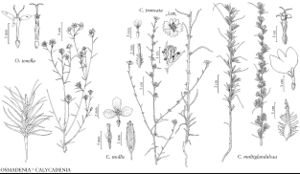Osmadenia
Trans. Amer. Philos. Soc., n. s. 7: 391. 1841.
| Taxon | Illustrator ⠉ | |
|---|---|---|
 | Osmadenia tenella Calycadenia mollis Calycadenia multiglandulosa | Yevonn Wilson-Ramsey Marjorie C. Leggitt Marjorie C. Leggitt |
Annuals, 5–40 cm (self-incompatible; herbage strongly scented). Stems erect (branched, branchlets relatively many, commonly spreading, threadlike, densely glandular, scabrous to shaggy-hairy). Leaves mostly cauline; alternate; sessile; blades linear, margins entire, faces hispidulous and glandular (proximally ± ciliate or shaggy-hairy). Heads radiate, in loose, cymiform arrays. Peduncular bracts with tack-glands 0 (strigillose, strongly glandular, margins often proximally pectinate, ciliate). Involucres ovoid, 2–4 mm diam. Phyllaries falling, 3–5 in 1 series (each partly enveloping a ray cypsela, apices acute to attenuate). Receptacles flat, glabrous, paleate (paleae persistent, in 1 series between rays and discs, connate, forming cups, distinct apices acute, often apiculate). Ray-florets 3–5, pistillate, fertile; corollas wholly or mostly white (laminae 3-lobed, lobes sometimes each with prominent medial red blotch, overall often fading reddish, sinuses ± equaling laminae). Disc-florets 3–10, bisexual, fertile; corollas usually wholly white, sometimes lobes each with prominent medial red blotch or reddish overall, tubes shorter than throats, lobes 5, deltate (anthers ± dark purple; styles glabrous proximal to branches). Cypselae (rays) ± obcompressed (± 3-angled, abaxial sides usually broadly 2-faced, angles between those faces usually 90+°, adaxial sides nearly flat), apices beaked, beaks off-center, faces rugose, glabrous; or (discs) narrowly clavate, appressed-hairy; pappi (rays) 0, or (discs) of 4–5 lance-attenuate to aristate scales alternating with 4–5 shorter, ± fimbriate scales. x = 9.
Distribution
Calif., nw Mexico
Discussion
Species 1.